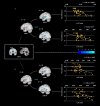Tai Chi's synergistic modulation on autonomic nervous activity and central autonomic networks in functional constipation patients: a randomized controlled trial
- PMID: 40603953
- PMCID: PMC12222652
- DOI: 10.1038/s41598-025-04088-z
Tai Chi's synergistic modulation on autonomic nervous activity and central autonomic networks in functional constipation patients: a randomized controlled trial
Abstract
Functional constipation (FCon) is characterized by disrupted brain-gut communication, representing a core pathophysiological mechanism. Physical exercise, a safe and cost-effective intervention, has been proven efficacy in ameliorating constipation symptoms and is a vital self-management strategy. Tai Chi, a traditional Chinese exercise, has been demonstrated to benefit both the gastrointestinal tract and the brain. However, the potential mechanism underlying Tai Chi's gastrointestinal regulatory effects through enhancement of brain-gut communication remains to be elucidated. This randomized controlled trial enrolled 80 FCon patients and 32 healthy subjects. Patients were randomized to either Tai Chi or aerobic exercise group. Both groups participated in four 60-min sessions per week for 8 weeks. Outcome measures included symptom severity, quality of life, autonomic neural function (assessed via heart rate variability), and brain activity. Both groups exhibited significant improvements in clinical symptoms, mood states, and heart rate variability post intervention. Tai Chi showed a marginal superiority over aerobic exercise in alleviating clinical symptoms. Notably, the neuroimaging findings suggested that Tai Chi effectively modulated the abnormal functional connectivity of the anterior insula within the central autonomic network in FCon patients, which was not observed in the aerobic exercise group. These modulations correlated with clinical symptoms and heart rate variability indices. Our study suggests that Tai Chi may facilitate the coordination between central and autonomic nervous functions by modulating functional connectivity of the anterior insula within the central autonomic network, and promoting sympathetic/parasympathetic balance, thereby enhancing the brain-gut communication. This may represent the underlying mechanism by which Tai Chi exerts gastrointestinal modulation to improve FCon symptoms.Trial registration: ChiCTR1800019781.
Keywords: Anterior insula; Functional magnetic resonance imaging; Parasympathetic; Resting-state functional connectivity; Tai Chi.
© 2025. The Author(s).
Conflict of interest statement
Declarations. Competing interests: The authors declare no competing interests.
Figures




Similar articles
-
Tai Chi as a mind-body exercise modulates endothelial function in coronary artery disease: A randomized clinical trial.Complement Ther Med. 2025 Sep;92:103201. doi: 10.1016/j.ctim.2025.103201. Epub 2025 Jun 18. Complement Ther Med. 2025. PMID: 40553955 Clinical Trial.
-
Tai Chi for chronic obstructive pulmonary disease (COPD).Cochrane Database Syst Rev. 2016 Jun 7;2016(6):CD009953. doi: 10.1002/14651858.CD009953.pub2. Cochrane Database Syst Rev. 2016. PMID: 27272131 Free PMC article.
-
Conservative, physical and surgical interventions for managing faecal incontinence and constipation in adults with central neurological diseases.Cochrane Database Syst Rev. 2024 Oct 29;10(10):CD002115. doi: 10.1002/14651858.CD002115.pub6. Cochrane Database Syst Rev. 2024. PMID: 39470206
-
Physical exercise training interventions for children and young adults during and after treatment for childhood cancer.Cochrane Database Syst Rev. 2016 Mar 31;3(3):CD008796. doi: 10.1002/14651858.CD008796.pub3. Cochrane Database Syst Rev. 2016. PMID: 27030386 Free PMC article.
-
The effect of Tai Chi in elderly individuals with sarcopenia and frailty: A systematic review and meta-analysis of randomized controlled trials.Ageing Res Rev. 2022 Dec;82:101747. doi: 10.1016/j.arr.2022.101747. Epub 2022 Oct 9. Ageing Res Rev. 2022. PMID: 36223875
Cited by
-
Global research on Chinese martial arts (1974-2025): A bibliometric and visualization-based analysis using Web of Science.Medicine (Baltimore). 2025 Aug 8;104(32):e43769. doi: 10.1097/MD.0000000000043769. Medicine (Baltimore). 2025. PMID: 40797508 Free PMC article.
References
-
- Mearin, F. et al. Bowel disorders. Gastroenterology. 10.1053/j.gastro.2016.02.031 (2016).
-
- Barberio, B., Judge, C., Savarino, E. V. & Ford, A. C. Global prevalence of functional constipation according to the Rome criteria: A systematic review and meta-analysis. Lancet Gastroenterol. Hepatol.6, 638–648. 10.1016/s2468-1253(21)00111-4 (2021). - PubMed
-
- Arco, S. et al. Functional constipation in older adults: Prevalence, clinical symptoms and subtypes, association with frailty, and impact on quality of life. Gerontology68, 397–406. 10.1159/000517212 (2022). - PubMed
-
- Serra, J. et al. European society of neurogastroenterology and motility guidelines on functional constipation in adults. Neurogastroenterol. Motil.32, e13762. 10.1111/nmo.13762 (2020). - PubMed
Publication types
MeSH terms
Grants and funding
LinkOut - more resources
Full Text Sources
Medical

